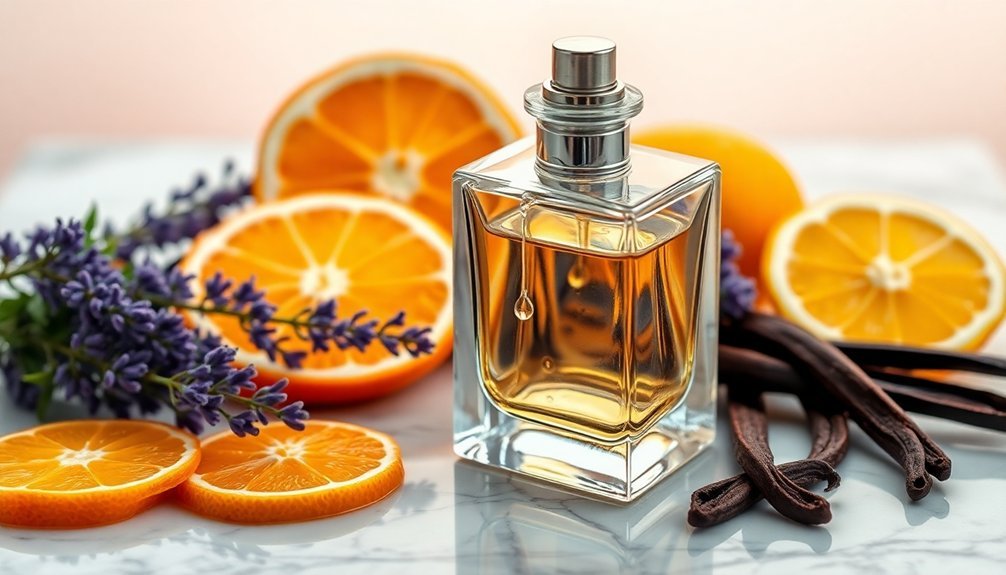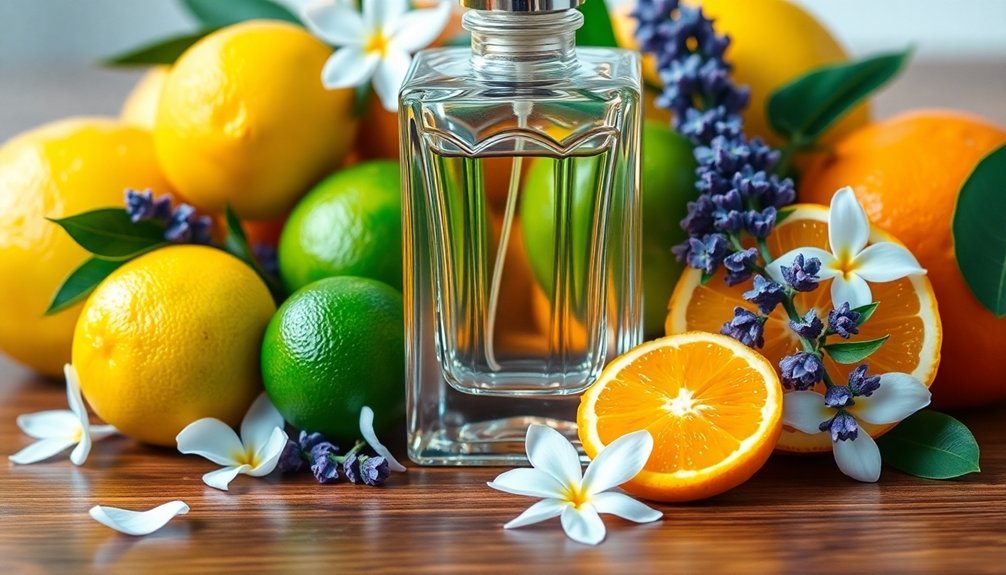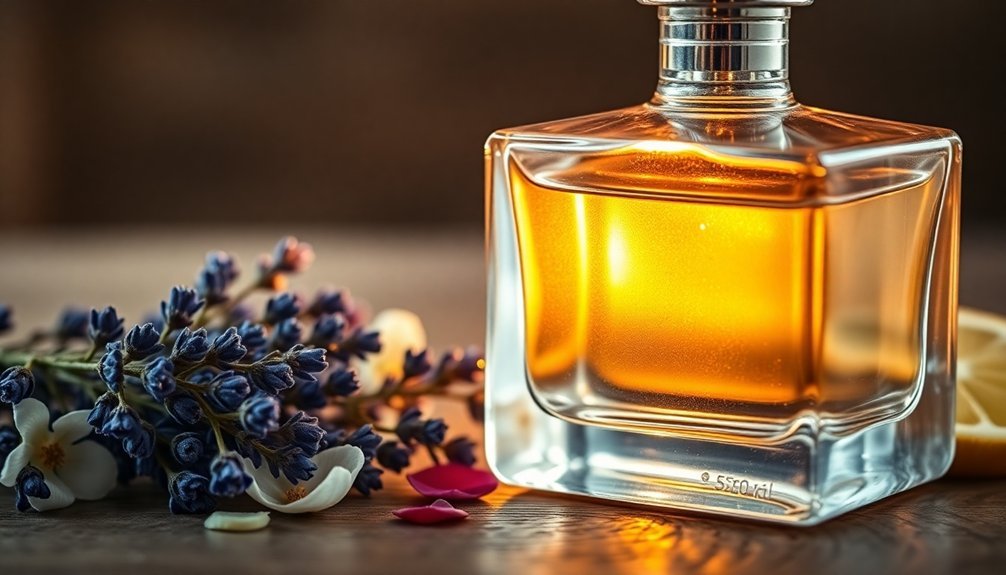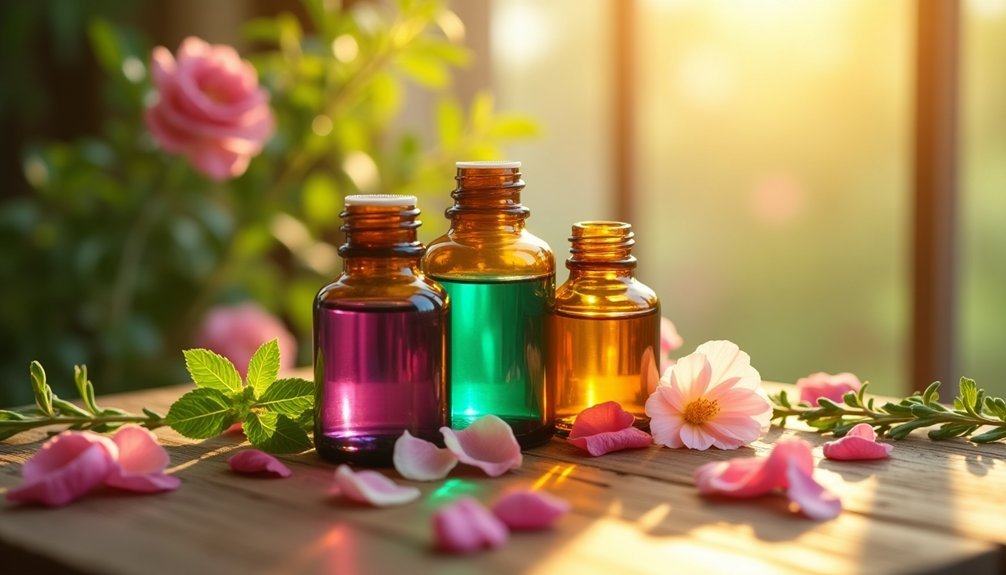To create long-lasting fragrance combinations, you'll need to master the three-tier note system. Start with fresh top notes like citrus (15-20%), then layer floral or spicy middle notes (30-35%) for character, and anchor with rich base notes (40-50%) such as vanilla or musk. Apply to properly moisturized skin at pulse points, and consider using matching scented products to enhance longevity. Understanding the intricate relationship between notes, skin chemistry, and application techniques will reveal your perfect signature scent.
Understanding the Three-Tier Fragrance Note System

When creating long-lasting fragrance combinations, you'll need to master the three-tier fragrance note system.
The structure begins with top notes, which provide the initial burst of scent and last 5-20 minutes, featuring fresh elements like citrus and peppermint.
Next, middle notes emerge within 20 minutes to 3 hours, making up about 70% of the fragrance with floral and spicy components like jasmine and cinnamon. Many of these notes are found in hard to find fragrances.
Base notes form the foundation, lasting over 6 hours and sometimes days on clothing. These deep, rich scents like vanilla and musk support the entire composition.
Think of it as a pyramid where each tier plays a significant role: top notes create first impressions, middle notes reveal true character, and base notes provide lasting power and depth.
The Science Behind Base Note Longevity
Base notes achieve their remarkable staying power through strong chemical bonds that lock aromatic molecules to your skin's surface.
The essential oils and musks in these base ingredients contribute significantly to the dry-down phase of the fragrance.
You'll find that these notes contain larger, heavier molecules with higher molecular weights, which naturally evaporate more slowly than their lighter counterparts in top and middle notes.
The rich, deep character of base notes comes from complex molecular structures in ingredients like woods and resins, which create a lasting foundation that can persist on your skin for hours or even days.
Chemical Bonding In Bases
Understanding the chemical bonding in fragrance base notes reveals why these components last so long on your skin. The secret lies in their large, heavy molecules containing carbonyl groups (C=O), which form strong bonds and evaporate slowly. You'll find these primarily in aldehydes and ketones, which create the foundation of lasting scents. The molecular weight of aldehydes significantly impacts their scent profile, with higher molecular weights producing more pleasant aromas.
| Bond Type | Stability | Common Examples |
|---|---|---|
| Carbonyl | High | Aldehydes |
| Resinous | Very High | Ambergris |
| Chelated | Medium-High | Stabilized Esters |
These molecules work with fixatives to create a stable structure that resists environmental factors. When you're choosing a fragrance, look for ones with strong base notes containing these bonds – they'll help lock in the scent. The interaction between these chemical bonds and fixatives guarantees your fragrance maintains its character throughout the day.
Molecular Weight Effects
The fascinating relationship between molecular weight and fragrance longevity explains why certain scents linger while others quickly fade.
When you're creating fragrances, you'll notice that heavier molecules, particularly those found in base notes like musks and woody scents, evaporate more slowly due to their lower volatility.
You'll get better longevity by incorporating complex molecular structures rather than simple, straight-chain shapes. That's why ingredients like patchouli and sandalwood persist longer on your skin.
To enhance this effect, you can use fixatives that bind to volatile molecules, creating a more stable scent profile.
Remember that your skin's pH level will influence how these molecules interact and evaporate. If you have more acidic skin, you'll typically experience longer-lasting fragrances compared to those with higher pH levels.
Rich Note Persistence
Rich fragrances with deep, lasting qualities stem from their molecular anchoring properties, building upon our previous discussion of molecular weight.
You'll find that base notes like musk, amber, and woody elements form the foundation of long-lasting scents due to their larger, more stable molecular structures.
These rich notes don't just evaporate slowly; they actively work to enhance your fragrance's longevity by anchoring the more volatile top notes.
As you wear your perfume, you'll notice the base notes becoming more prominent over time, creating a deeper, more complex scent profile. This is particularly evident in fragrances with higher concentrations of woody and resinous materials.
The base notes' slow evaporation rate guarantees your fragrance maintains its character throughout the day, while their synergistic properties help create a smooth shift between different scent phases.
Essential Oil Combinations for Extended Wear
Creating long-lasting fragrances requires mastering five essential oil categories: citrus, floral, herbal, spicy, and woody oils. You'll want to combine these strategically for maximum longevity and appeal.
Start with citrus oils like bergamot or lemon as your top notes, providing an initial burst of freshness.
Layer in floral oils such as lavender or ylang ylang for your middle notes, creating the fragrance's heart.
Add depth with herbal oils like basil or eucalyptus, which blend seamlessly with spicy oils such as cinnamon or clove.
For extended wear, anchor your blend with woody base notes like cedarwood or sandalwood.
You can enhance the staying power further by incorporating resinous oils like frankincense or earthly notes like patchouli.
These base notes will help your fragrance last throughout the day.
Mastering Top Note Selection for First Impressions

Have you ever wondered why certain fragrances captivate you within seconds? It's all about the top notes – those initial scents that greet your senses and set the stage for your entire fragrance experience. These volatile compounds create powerful first impressions that can trigger memories and emotions instantly.
To master top note selection, you'll need to understand how different scents affect your mood and perception:
| Note Type | Characteristics | Emotional Effect |
|---|---|---|
| Citrus | Fresh, zesty, bright | Energizing, uplifting |
| Herbal | Clean, natural, green | Calming, focusing |
| Light Floral | Delicate, airy, sweet | Romantic, soothing |
| Spicy | Warm, sharp, distinctive | Stimulating, exciting |
When selecting top notes, trust your instincts and pay attention to how they evolve into the heart notes. Your perfect combination should create an immediate connection while maintaining harmony with the fragrance's full composition.
Heart Notes: Building Your Fragrance Core
The heart notes in your fragrance serve as its defining soul, emerging after those initial top notes fade away. Making up 40-80% of your perfume's composition, these notes create the true character of your scent and last for several hours on your skin.
When selecting heart notes, you'll find classic options like rose, ylang ylang, cinnamon, and neroli. These middle notes interact uniquely with your body chemistry, creating a personalized scent signature that's distinctly yours.
They'll work to connect the gap between your fragrance's opening burst and its deep base notes.
To maximize your heart notes' impact, consider how they'll blend with both top and base notes. The right combination will guarantee a smooth shift throughout your fragrance's evolution while maintaining a consistent and memorable presence.
Strategic Layering Techniques for All-Day Scent

Your most effective fragrance layering starts with properly prepared skin, so you'll want to begin with thorough cleansing and moisturizing.
You'll get the best results by matching your foundational scents, particularly focusing on complementary base notes across your body wash, lotion, and perfume choices.
Paying attention to these fundamentals guarantees your layered fragrances will blend seamlessly and last throughout the day.
Prep Skin First
Creating long-lasting fragrance starts with properly prepping your skin through strategic layering techniques. Begin with a scented shower gel to establish your base layer, then follow with a hydrating, scented body lotion that'll help secure the fragrance. Focus on your pulse points – wrists, neck, and behind the ears – as these areas naturally diffuse scent throughout the day.
| Prep Step | Product Type | Key Benefits |
|---|---|---|
| Cleanse | Scented Shower Gel | Creates base layer |
| Moisturize | Scented Body Lotion | Secures fragrance |
| Target | Fragrant Powder | Adds subtle layers |
| Protect | Matching Deodorant | Maintains consistency |
Remember to choose gentle products that won't irritate your skin, and stick to complementary scent families for a cohesive fragrance profile. This foundation guarantees your perfume will have staying power throughout the day.
Matching Base Notes Essential
Building upon proper skin preparation, successful fragrance layering hinges on understanding and matching base notes effectively. To maximize your fragrance's longevity, focus on strategic base note combinations like vetiver, sandalwood, and vanilla, which can last six hours or more on your skin.
When selecting complementary base notes, guarantee they work harmoniously with your chosen middle and top notes, typically keeping base notes at 5-10% of the total blend.
You'll achieve the best results by:
- Applying scented body lotions that match your perfume's base notes
- Strategically placing fragrance on pulse points, where base notes can slowly release throughout the day
- Using the Vaseline trick on pulse points before applying perfume to lock in the scent
These techniques will help create a long-lasting, well-balanced fragrance that maintains its character throughout wear.
Perfume Oil Concentration and Lasting Power
The science of fragrance concentration plays a crucial role in determining how long your perfume will last throughout the day. Understanding these concentration levels will help you choose the right fragrance for your needs and budget.
| Type | Concentration | Longevity |
|---|---|---|
| Parfum | 20-40% | 6-8 hours |
| EDP | 15-20% | 4-6 hours |
| EDT | 5-15% | 3-5 hours |
| EDC | 2-5% | 2-3 hours |
| Eau Fraiche | 1-3% | 1-2 hours |
If you're looking for maximum lasting power, you'll want to invest in a Parfum or EDP. While they're more expensive, their higher oil concentrations mean you'll need fewer applications throughout the day. For casual wear, EDT offers a great balance of projection and value. Choose EDC or Eau Fraiche when you want a subtle, invigorating scent that won't overwhelm.
Natural Vs Synthetic Notes: Impact on Duration

When choosing between natural and synthetic fragrance notes, you'll need to contemplate their significant differences in longevity and performance.
Natural notes typically last 1-2 years and offer complex, multifaceted aromas but lack the staying power of their synthetic counterparts. Synthetic notes can remain stable for up to five years and provide consistent results in your perfume formulations.
Consider these key factors when selecting your notes:
- Natural fragrances require more frequent reapplication due to their shorter-lasting properties and lack of fixatives.
- Synthetic notes maintain their scent profile longer but may have environmental implications due to petrochemical use.
- A blend of both types often yields the best results, combining natural complexity with synthetic stability.
The choice ultimately depends on your priorities regarding longevity, environmental impact, and desired fragrance characteristics.
Seasonal Note Combinations That Endure
Creating enduring seasonal fragrances requires strategic pairing of complementary notes that align with specific weather patterns and emotional associations.
For spring, combine jasmine and rose with citrus undertones, adding green accords to anchor the floral notes.
In summer, blend light marine notes with orange blossom and honeysuckle, incorporating sea minerals for lasting freshness.
Fall fragrances benefit from layering woody bases like sandalwood with warm spices and amber, while adding vanilla or tonka bean extends their longevity.
Winter calls for rich combinations: pair oriental spices with dark florals and smoky notes, or layer woody elements with black rose and vanilla.
You'll find that frankincense and myrrh create particularly enduring winter scents when combined with gourmand notes like caramel or black coffee.
Body Chemistry and Note Performance

Your skin's natural oil levels play an essential role in how long fragrances last, with oilier skin helping perfume molecules stick around longer.
Your body temperature affects the intensity of fragrance notes, as warmth can make scents project more strongly and evolve more quickly.
The pH level of your skin directly impacts how well fragrances are absorbed and retained, with slightly acidic skin providing the ideal environment for best scent performance.
Natural Skin Oil Impact
The intricacy of natural skin oils plays a decisive role in how fragrances interact with your body. Your skin's natural oils act as fixatives, helping to stabilize different fragrance notes and slow down their evaporation rate. These oils greatly influence how each note performs, from the initial burst of top notes to the lingering base notes.
To maximize your fragrance's longevity and performance, consider these key aspects of natural skin oil interaction:
- Top notes interact immediately with your skin oils but evaporate quickly, creating the first impression.
- Heart notes blend with your natural oils for up to an hour, developing the fragrance's character.
- Base notes work harmoniously with skin oils to create a lasting foundation that can persist for hours.
The quality of this interaction depends heavily on your skin's pH levels and moisture content, making each person's fragrance experience unique.
Temperature Affects Note Intensity
Body chemistry interacts closely with temperature to shape how fragrance notes perform on your skin.
If you're naturally warm-blooded or live in a hot climate, you'll notice your fragrances project more intensely but fade faster, with top and middle notes becoming more prominent. You'll need more frequent reapplications in these conditions.
If you run cool or live in colder areas, your fragrances will develop more gradually and last longer, with base notes becoming more pronounced.
The humidity level also plays a significant role – high humidity can help lock in your fragrance and enhance its longevity, though it may alter how the scent interacts with your sweat.
To optimize performance, consider applying fragrances to pulse points if you're cool-skinned, or to cooler areas if you tend to run warm.
Ph Levels Matter
While many fragrance enthusiasts focus on scent profiles alone, skin pH plays an essential role in how perfumes perform throughout the day. Your skin's natural pH, typically between 4.5 and 5.5, directly impacts how fragrance notes evolve and last on your skin.
If you've got acidic skin, you'll notice citrusy top notes fade faster, while higher pH levels intensify musky base notes. Understanding your skin's pH can help you choose fragrances that work best with your body chemistry.
- Oily skin tends to make fragrances last longer and project more intensely.
- Dry skin causes scents to fade faster and appear less prominent.
- Normal skin with balanced pH provides ideal fragrance performance.
Consider choosing fragrances with stronger heart and base notes if you have acidic skin, or opt for sharper notes if your skin's more alkaline.
Blending Techniques for Extended Fragrance Life

Creating long-lasting fragrance combinations requires more than simply layering different scents together. You'll need to understand how different fragrance families interact and complement each other for the best results.
Start by pairing floral scents with woody notes like sandalwood or cedar to create depth. Alternatively, blend citrus with oriental fragrances for a fresh yet indulgent combination. If you're drawn to sweeter scents, try layering fruity notes with gourmand fragrances. For unique combinations, experiment with cardamom and cedarwood.
To maximize longevity, apply a matching or neutral-scented body lotion after showering to create a moisturized base.
Then, strategically apply your fragrance to pulse points, but don't rub your wrists together. For extra staying power, dab Vaseline on pulse points before applying perfume.
Note Ratios for Maximum Staying Power
Understanding the right ratios between fragrance notes is essential for achieving peak staying power in your perfume combinations.
You'll want to create a balanced formula that incorporates higher concentrations of base notes, particularly woods and musks, which naturally last longer on the skin.
For ideal longevity, consider these proven note ratios:
- Base notes should comprise 40-50% of your blend, focusing on rich ingredients like cedar and oud
- Middle notes should make up 30-35% of the composition to provide a stable heart
- Top notes should account for 15-20%, just enough to create an initial impression
When you're working with different concentrations, remember that a parfum-strength formula (20-40% oils) will provide the longest wear time.
Creating Signature Scents With Lasting Appeal

A signature scent becomes truly memorable when it combines personal style with proven longevity techniques.
To create your distinctive fragrance, start by selecting high-concentration perfume oils that align with your preferred fragrance family, whether floral, woody, or oriental.
Layer your scent strategically by applying complementary products first, such as scented lotions or oils, to enhance staying power.
Then, build your unique combination by incorporating harmonious accords: start with lighter top notes, follow with stabilizing middle notes, and anchor with rich base notes.
Don't forget to test your creation on pulse points for at least 24 hours to understand how it interacts with your skin chemistry.
Remember to adjust your signature blend seasonally and consider environmental factors that might affect its performance throughout the day.
Frequently Asked Questions
Can Pregnant Women Safely Layer Multiple Fragrance Notes?
You can layer fragrances while pregnant, but stick to phthalate-free, natural options. Choose 2-3 complementary scents, test them first, and listen to your body's reactions to guarantee comfort and safety.
Do Medication Types Affect How Fragrance Notes Perform on Skin?
Yes, your medications can affect how fragrances perform on your skin. Topical treatments and oral medications may alter your skin's chemistry, barrier function, and pH levels, impacting how fragrance notes develop and last.
Why Do Some People Completely Lose Sensitivity to Certain Notes?
You can lose sensitivity to fragrance notes through olfactory fatigue, where your nose adapts and "tunes out" familiar scents. Overexposure to specific notes can temporarily reduce your ability to detect them.
How Does Altitude Affect the Evaporation Rate of Fragrance Notes?
At higher altitudes, you'll notice your fragrances evaporate faster due to lower air pressure. Top notes disappear quickest, while base notes fade more gradually. You'll need to reapply more often to maintain scent intensity.
Can Fragrance Notes Trigger Migraines in Sensitive Individuals?
Yes, if you're sensitive, fragrance notes can trigger migraines through your trigeminal nerve system. You'll need to be careful with floral scents, cleaning products, and strong perfumes to avoid potential headaches.
In Summary
You've now mastered the fundamentals of creating long-lasting fragrances. By understanding the three-tier system, selecting complementary notes, and considering your body chemistry, you can craft scents that truly endure. Remember to balance your ratios carefully and test your combinations before finalizing them. With these skills, you'll create signature fragrances that don't just smell amazing but stand the test of time.





Leave a Reply